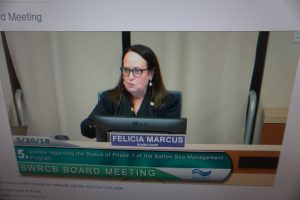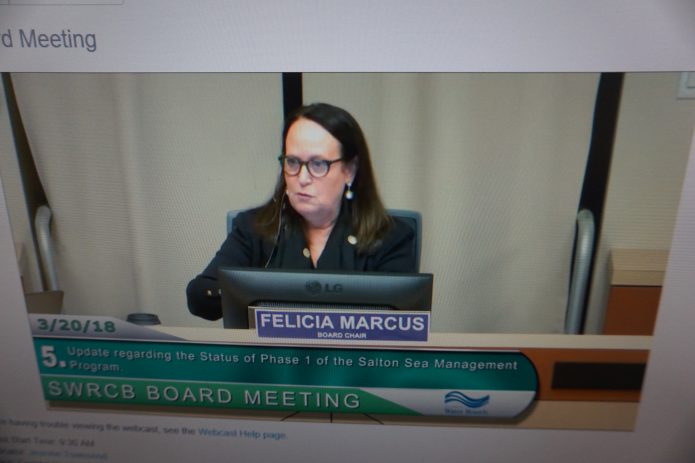
State Water Resources Control Board Chairwoman Felicia Marcus comments on the progress of the State Salton Sea Management Program during a workshop held by the Water Board in Sacramento on March 16.
The State Water Resources Control Board (Water Board) spoke of the need to work collaboratively and think creatively to address the challenges ahead at the Salton Sea during the Water Board’s first review of the Salton Sea Management Program (SSMP) Phase 1 progress since approving the Stipulated Order in November. The Stipulated Order set annual milestones for the State’s phased approach to Salton Sea restoration being implemented as the SSMP. Phase 1 of the SSMP is a 10-year plan, which includes creation of 30,000 acres of habitat and dust control projects. During the review held Tuesday, March 20, in Sacramento, the Water Board declared it would review the State’s progress on the SSMP Phase 1 every six months as opposed to holding annual reviews—as originally directed under the Stipulated Order.
As part of Tuesday’s presentation, Bruce Wilcox, assistant secretary of California Natural Resources in charge of Salton Sea policy, provided an update to the Water Board on the SSMP. It was a report that included progress on some fronts, but challenges on others. One SSMP project, a small wetlands area built on the Sea’s northern shore on Torres Martinez Desert Cahuilla Tribal land, is now complete. The State also added a new project to the SSMP near the Desert Shores community along the Sea that would repurpose land once used as a dock, covering the area with water that could serve as habitat. Despite such progress, Wilcox pointed out there have been delays in moving forward with the Species Conservation Habitat Project, a 680-acre project along the southern shore that calls for building a series of ponds to support fish life, serve the needs of migratory birds, and prevent playa from becoming emissive. This delay is the result of the ability to obtain an easement that would enable the project to move forward. He said the parties involved continue to evaluate various options for addressing concerns regarding liability and other issues and finalizing the necessary agreements to advance this project.
Under the milestones established by the Stipulated Order, the State is to create 500 acres of dust control or habitat projects by the end of 2018. Some who attended Tuesday’s workshop voiced concern whether the State will be able to meet that first target. Wilcox responded that once the issues are addressed, projects would move forward quickly under a design-build plan. If delays continue, however, he said the State is looking at other land along the Sea where projects could be built.
Board member Steven Moore said there has to be collaboration and sharing of risks both on the part of the State and local communities. Board Chairwoman Felicia Marcus said everyone needs to continue working on these issues, and she asked Wilcox to provide more information in the future on what “he is not getting” in terms of support that would prevent him from successfully meeting SSMP milestones. It was Marcus who suggested the Water Board, which under the Stipulated Order has continuing jurisdiction over the State’s restoration effort, review the progress on the SSMP every six months as opposed to once a year. “Especially, in the beginning, it is important,” she said.
Joaquin Esquivel, a member of the Water Board, said there needs to be a greater sense of urgency at the sea—the kind matching the sense of urgency surrounding projects on the Bay Delta in Northern California. He also asked that in the next update, the Water Board receive not only an update on SSMP progress, but also on the status of the environmental mitigation efforts of the Joint Powers Authority formed under the Quantification Settlement Agreement.
Throughout Tuesday’s workshop there was an undercurrent of hope but a sense of concern regarding progress on the projects. As always, funding remains a critical issue, and attention is now focused on Proposition 68, the June water and parks bond measure that would provide $200 million to the Sea for restoration. If approved this additional funding would cover much of the cost of the SSMP’s Phase 1 plan.
